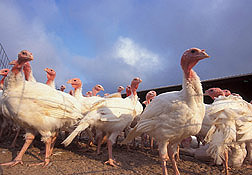Science Update
Know Your USDA Watersheds
Information collected over the past 40 years from large watersheds across the country is available online for the first time on a Web-based system called STEWARDS (Sustaining the Earth’s Watersheds, Agricultural Research Data System). The site (http://129.186.109.10/stewards.1) allows users to download watershed data, view watershed topography, and see where monitoring instruments are located.
Users can also obtain information on pesticides, nitrogen, phosphorus, and other pollutants in streams, rivers, lakes, and drinking-water reservoirs. Data on daily stream discharge levels, air and soil temperature, and weather measurements is also posted.
STEWARDS was developed because Conservation Effects Assessment Project researchers, who study how private landowners benefit the environment when they participate in USDA conservation programs, wanted to make the watershed data available for nationwide analyses. STEWARDS data can be valuable for other hydrological analyses and to people living in these watersheds.
Jean Steiner, ARS Grazinglands Research Laboratory, El Reno, OK; (405) 262-5291.
It Pays To Furrow Dike
Farmers who use furrow diking in their fields plow soils into ridge-like barriers that run alongside row crops. The ridges hold water and allow it to soak into the soil instead of washing away. Researchers compared the effects on runoff and erosion in southeast U.S. cotton fields with and without furrow diking. They found that furrow diking during a moderate drought saved farmers 1 inch of irrigation water per acre, reduced runoff by 28 percent, and curbed soil erosion.
The following year, when drought conditions were more severe, it saved 5 inches of irrigation water per acre. The scientists also compared crop yields, water needs, and the effects of different irrigation rates between tracts of furrow-diked cotton and traditionally tilled cotton. Results indicated that in 1 of 3 years, cotton yield and net return were higher with furrow diking over four irrigation regimes, including dryland.
Russell C. Nuti, National Peanut Research Laboratory, Dawson, GA 39842; (229) 995-7449.
Clinton C. Truman, Southeast Watershed Research Unit, Tifton, GA 31793; (229) 386-7174.
Avian Bacterium More Dangerous Than Believed
Bordetella avium is a pathogenic bacterium that causes upper respiratory disease in poultry and wild birds. Until recently, B. hinzii, which is very similar to B. avium, was believed to be nonpathogenic in poultry. Scientists used highly specific, DNA-based tests to examine several Bordetella isolates, including some that had caused 100 percent morbidity in turkey poults. They found that the isolates were actually B. hinzii, even though the pathogens had initially been labeled as B. avium.
The scientists then tested the bacterium’s pathogenicity by trying to infect turkeys with six genetically distinct strains of B. hinzii. Four of the strains were able to grow and persist in the trachea and cause clinical disease, though none demonstrated 100 percent morbidity, and the severity of clinical signs of disease varied.
This is the first study to show that some strains of B. hinzii can cause disease in turkeys.
Karen B. Register and Robert A. Kunkle, National Animal Disease Center, Ames, IA 50010; (515) 337-7700 [Register], (515) 337-7190 [Kunkle].
Conservation Tillage and Cotton: The Bottom Line
From 2000 to 2004, scientists examined the economic returns for five different cotton tillage practices in the Mississippi Delta, including conventional tillage, no-till, low-till sub-soiling, no-till with a winter wheat cover crop, and low-till subsoiling with a winter wheat cover crop. The costs for each system were tracked, including all direct and fixed production expenses related to subsoiling, seed preparation, cover crop planting, and preplant herbicide application. Interest expense, labor, and the fixed costs of equipment ownership were also assessed.
Their results suggest that cotton farmers could realize the highest economic return by using no-till production. This system, which averaged a net return of $1,202 per hectare (2.471 acres), had the lowest production costs because fewer trips were needed across each field for tillage or cover crop plantings. The scientists also determined that a no-till cover crop management system had the highest mean net return of the two cover crop systems in the study.
James E. Hanks, Crop Production Systems Research Unit, Stoneville, MS 38776; (662) 686-5382.
"Science Update" was published in the January 2010 issue of Agricultural Research magazine.







